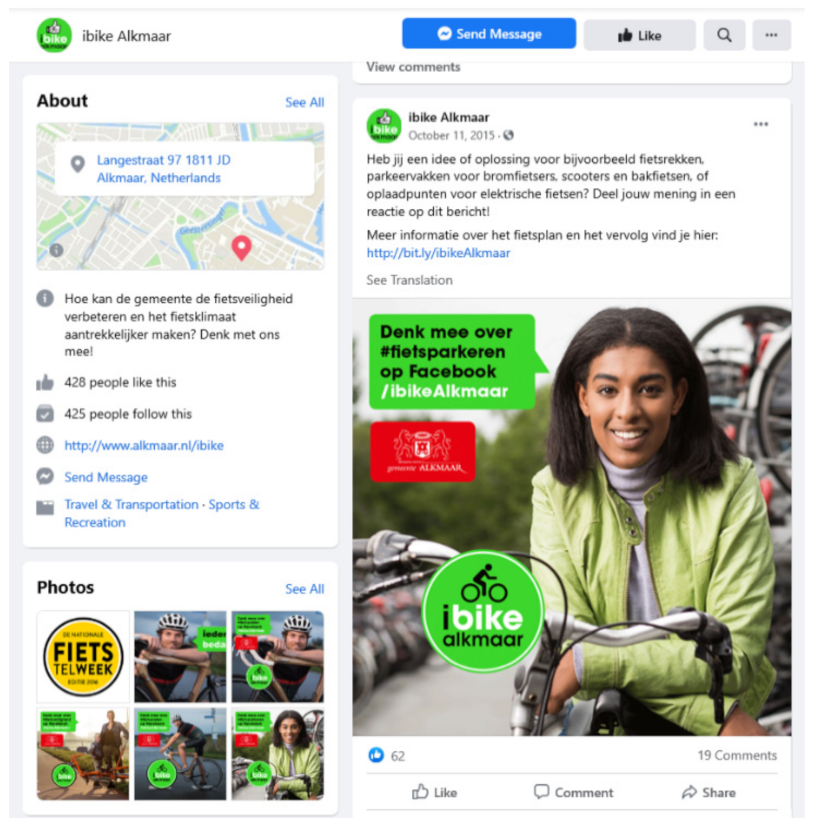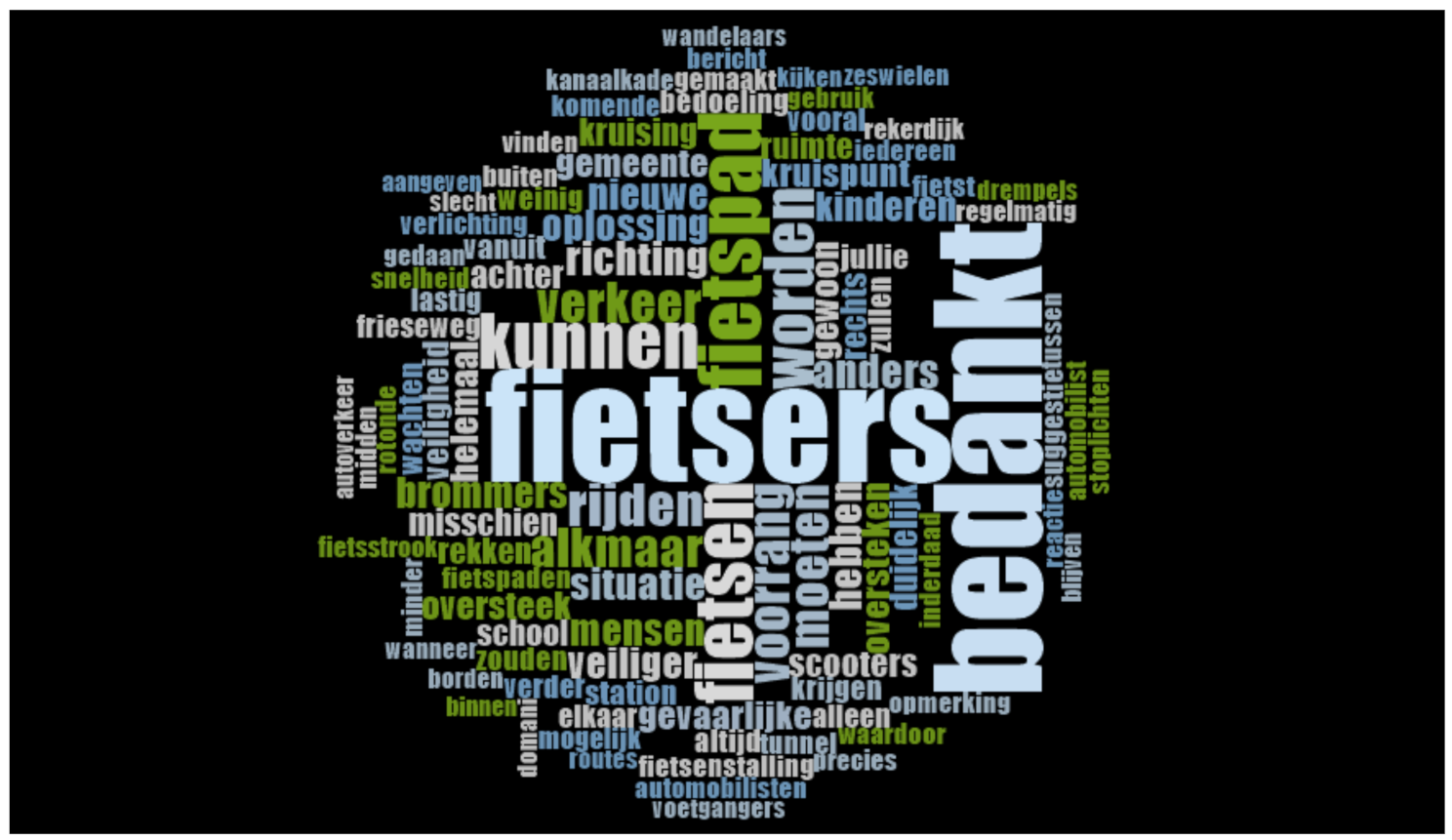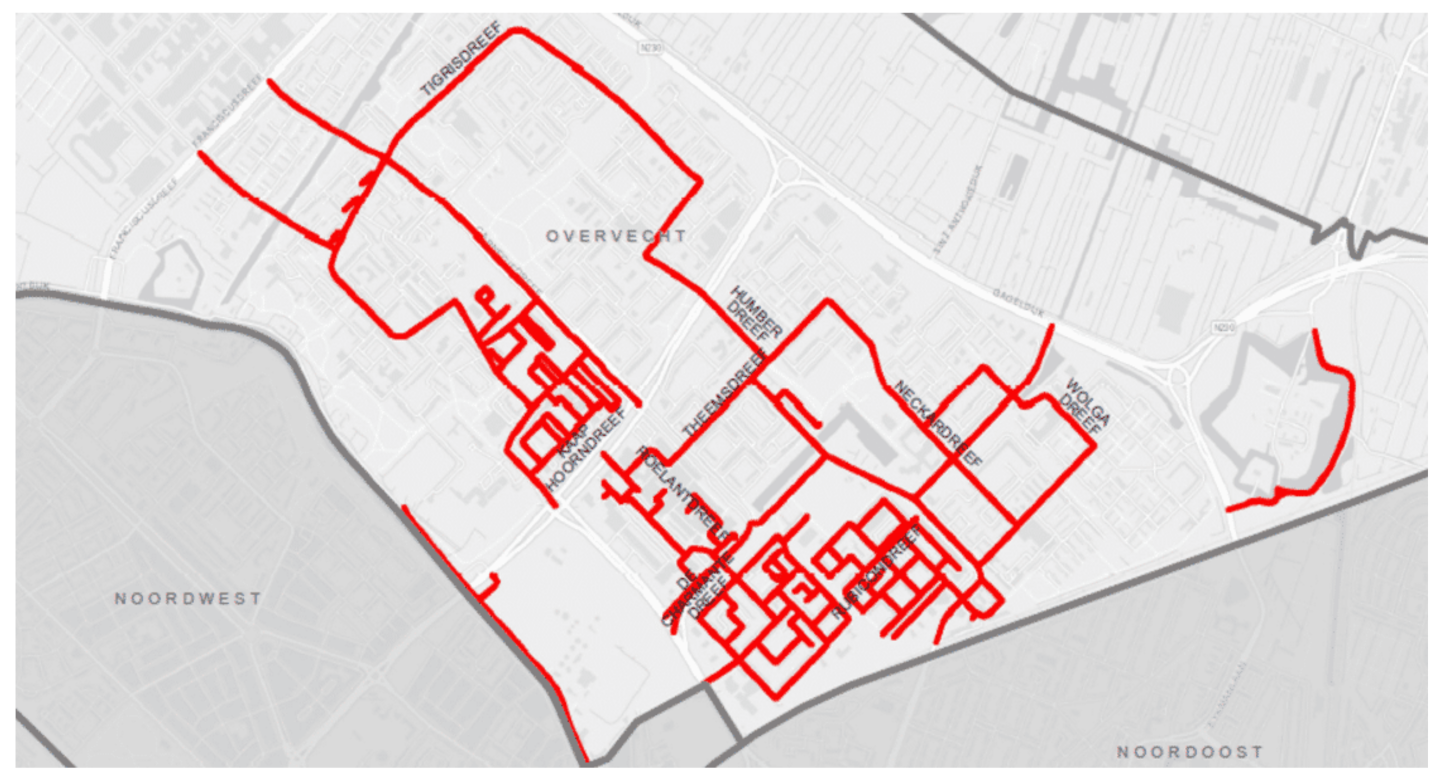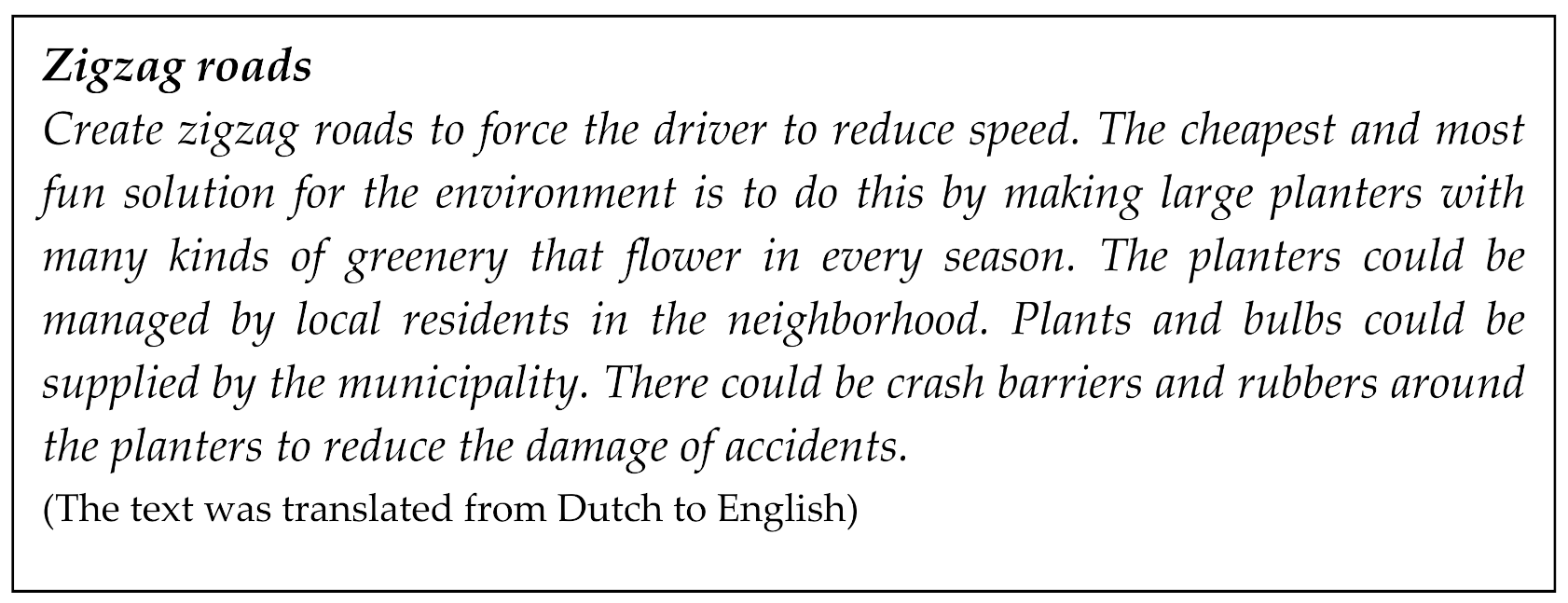Using Social Media for Citizen Participation: Contexts, Empowerment, and Inclusion
Abstract
1. Introduction
2. Literature Review
2.1. Citizen Participation: Empowerment and Contexts
2.2. Social Media Participation and Social Inclusion
3. Methods and Data Collection
4. Empirical Work
4.1. Ibike Alkmaar Campaign
4.1.1. Policy Context in Alkmaar
“The social media policy, which the municipality now has, did not exist in 2015 or was very much in the early stage. The communication department did not set up any program in the field of social media at all. At the time, we mainly used Facebook when there were disasters or crises.”
4.1.2. Citizen Participation through Facebook
“You can see all comments for our messages (in the Facebook page @ibikeAlkmaar)… People speak their mind freely. Even they discuss it via their (personal) profiles on Facebook. The fact that the Facebook profiles are still behind them apparently doesn’t matter. If you engage people, for example, a walk-in evening in which they meet someone face to face, they express their opinions in a more nuanced way.”
4.2. The Regeneration of Traffic Routs in Overvecht in Utrecht
4.2.1. Policy Context in Utrecht
4.2.2. Online and Offline Engagement
“People came up with ideas that were really thought through. Some people even came up with design drawings about what they imagined. We asked them to provide not only a title of an idea, but also a summary of the idea and further elaboration. Some people were really active about this. Therefore, we got more (input) than only asking them questions in a meeting” (interview, May 2020).
5. Discussion and Conclusions
Author Contributions
Funding
Institutional Review Board Statement
Informed Consent Statement
Data Availability Statement
Conflicts of Interest
References
- Bäcklund, P.; Mäntysalo, R. Agonism and institutional ambiguity: Ideas on democracy and the role of participation in the development of planning theory and practice. Plan. Theory 2010, 9, 333–350. [Google Scholar] [CrossRef]
- Brown, G.; Chin, S. Assessing the effectiveness of public participation in neighborhood planning. Plan. Pract. Res. 2013, 28, 563–588. [Google Scholar] [CrossRef]
- Arnstein, S. A ladder of citizen participation. JAPA 1969, 35, 216–224. [Google Scholar] [CrossRef]
- Rowe, G.; Frewer, L. Public participation methods: A framework for evaluation. Sci. Technol. Hum. Values 2000, 25. [Google Scholar] [CrossRef]
- Bason, C. Leading Public Design: Discovering Human-Centred Governance; Policy PRESS: Bristol, UK, 2017. [Google Scholar]
- Zhang, L.; Lin, Y.; Hooimeijer, P.; Geertman, S. Heterogeneity of public participation in urban redevelopment in Chinese cities: Beijing versus Guangzhou. Urban Stud. 2019, 57, 1903–1919. [Google Scholar] [CrossRef]
- Kleinhans, R.; Van Ham, M.; Evans-Cowley, J. Using Social Media and Mobile Technologies to Foster Engagement and Self-Organization in Participatory Urban Planning and Neighbourhood Governance. Plan. Pract. Res. 2015, 30, 237–247. [Google Scholar] [CrossRef]
- Lin, Y.L.; Benneker, K. Assessing collaborative planning and the added value of planning support app: A case study of the Netherlands. Environ. Plan B Urban Anal. City Sci. 2021. [Google Scholar] [CrossRef]
- Lin, Y.L.; Geertman, S. Can social media play a role in urban planning? A literature review. In Computational Planning and Management for Smart Cities; Geertman, S., Zhan, Q.M., Allan, A., Pettit, C., Eds.; Springer Nature Switzerland AG: Cham, Switzerland, 2019. [Google Scholar]
- Mergel, I. Social Media in the Public Sector: Participation, Collaboration and Transparency in the Networked World; Jossey-Basss: Hoboken, NJ, USA, 2012. [Google Scholar]
- Piccorelli, J.T.; Stivers, C. Exiled to Main Street: How government’s use of social media diminishes public space. J. Public Aff. 2019, 19. [Google Scholar] [CrossRef]
- López-Ornelasa, E.; Abascal-Mena, R.; Zepeda-Hernández, S. Social media participation in urban planning: A new way to interact and take decision. In Proceedings of the 2nd International Conference on Smart Data and Smart Cities, Puebla, Mexico, 4–6 October 2017; The International Archives of the Photogrammetry, Remote Sensing and Spatial Information Sciences: Puebla, Mexico, 2017; Volume XLII-4/W3. [Google Scholar]
- CIVITAS Policy Note. The Use of Social Media to Involve Citizens in Urban Mobility Projects and City Planning. 2015. Available online: http://civitas.eu/content/civitas-policy-notethe-use-social-media-involve-citizens-urban-mobility-projects-and-city (accessed on 15 July 2015).
- Deng, Z.H.; Lin, Y.L.; Wang, S.F.; Zhao, M.X. Collaborative planning in the new media age: The Dafo Temple controversy in Guangzhou, China. Cities 2015, 45, 41–50. [Google Scholar] [CrossRef]
- Lin, Y.L. A comparison of selected Western and Chinese smart governance: The application of ICT in governmental management, participation and collaboration. Telecommun. Policy 2018, 42, 800–809. [Google Scholar] [CrossRef]
- Verdegem, P. Social media for digital and social inclusion: Challenges for information society 2.0 research & policies. TripleC 2011, 9, 28–38. [Google Scholar]
- Ruths, D.; Pfeffer, J. Social media for large studies of behavior. Science 2014, 346, 1063–1064. [Google Scholar] [CrossRef] [PubMed]
- Bakshay, E.; Messing, S.; Adamic, L. Exposure to ideologically diverse news and opinion on Facebook. Science 2015, 348, 1130–1132. [Google Scholar] [CrossRef] [PubMed]
- Osatuyi, B. Information sharing in social media. Comput. Hum. Behav. 2013, 29, 2622–2631. [Google Scholar] [CrossRef]
- Feeney, M.K.; Porumbescu, G. The limits of social media for public administration research & practice. Public Adm. Rev. 2020. [Google Scholar] [CrossRef]
- CBS. More Elderly Active on Social Media. 2020. Available online: https://www.cbs.nl/en-gb/news/2020/04/more-elderly-active-on-social-media (accessed on 20 January 2020).
- Statista. Number of Individuals Using the Leading Social Media Platforms in the Netherlands in 2020, by Social Network. 2020. Available online: https://www.statista.com/statistics/579626/social-media-penetration-in-the-netherlands-by-social-network/ (accessed on 20 January 2020).
- Boonstra, B.; Boelens, L. Self-organization in urban development: Towards a new perspective on spatial planning. Urban Res. Pract. 2011, 4, 99–122. [Google Scholar] [CrossRef]
- Pflughoeft, B.R.; Schneider, I.E. Social media as e-participation: Can a multiple hierarchy stratification perspective predict public interest? Gov. Inf. Q. 2020, 37, 101–422. [Google Scholar] [CrossRef]
- Driessen, P.P.; Dieperink, C.; Laerhoven, F.; Runhaar, H.A.; Vermeulen, W.J. Towards a conceptual framework for the study of shifts in modes of environmental governance—Experiences from the Netherlands. Environ. Policy Gov. 2012, 22, 143–160. [Google Scholar] [CrossRef]
- Patten, S. Democratizing the Institutions of Policy-making: Democratic Consultation and Participatory Administration. J. Can. Stud. 2001, 35, 221–239. [Google Scholar] [CrossRef]
- Laurian, L.; Shaw, M. Evaluation of public participation: The practices of certified planners. J. Plan. Educ. Res. 2009, 28, 293–309. [Google Scholar] [CrossRef]
- Ministerie van Infrastructuur en Milieu. De Opgaven voor de Nationale Omgevingsvisie; Ministerie van Infrastructuur en Milieu: Den Haag, The Netherlands, 2017.
- Ertiö, T.-P. Participatory Apps for Urban Planning—Space for Improvement. Plan. Pract. Res. 2015, 30, 303–321. [Google Scholar] [CrossRef]
- Mukhtarov, F.; Dieperink, C.; Driessen, P. The influence of information and communication technologies on public participation in urban water governance: A review of place-based research. Environ. Sci. Policy 2018, 89, 430–438. [Google Scholar] [CrossRef]
- Kaplan, A.M.; Haenlein, M. Users of the world, unite! The challenges and opportunities of Social Media. Bus. Horiz. 2010, 53, 59–68. [Google Scholar] [CrossRef]
- Mossberger, K.; Wu, Y.; Crawford, J. Connecting citizens and local governments? Social media and interactivity in major U.S. cities. Gov. Inf. Q. 2013, 30, 351–358. [Google Scholar] [CrossRef]
- Hoffken, S.; Streich, B. Mobile participation: Citizen engagement in urban planning via smartphones. In Citizen E-Participation in Urban. Governance: Crowdsourcing and Collaborative Creativity; Silva, C., Ed.; IGI Global: Hershey, PA, USA, 2013. [Google Scholar]
- Fredericks, J.; Foth, M. Augmenting public participation: Enhancing planning outcomes through the use of social media and web 2.0. Aust. Plan. 2013, 50, 244–256. [Google Scholar] [CrossRef]
- Tayebi, A. Planning activism: Using social media to claim marginalized citizens’ right to the city. Cities 2013, 32, 88–93. [Google Scholar] [CrossRef]
- Kaplan, D. E-inclusion: New Challenges and Policy Recommendations. Brussels: eEurope Advisory Group. 2005. Available online: https://generationen.oehunigraz.at/files/2012/09/kaplan_report_einclusion_final_version.pdf (accessed on 20 January 2020).
- Holsti, O.R. Content Analysis for the Social Sciences and Humanities; Addison Wesley: Reading, MA, USA, 1969. [Google Scholar]
- Lai, L.S.L.; To, W.M. Content analysis of social media: A grounded theory approach. J. Electron. Comme Res. 2015, 16, 138–152. [Google Scholar]
- Municipality of Alkmaar. Lekker Fietsen! In de Gemeente Alkmaar. 2016. Available online: https://fietsmaar.files.wordpress.com/2016/06/b-_fietsplan2016-2020.pdf (accessed on 15 June 2016).
- Castells, M. A network theory of power. Int. J. Commun. 2011, 5, 773–787. [Google Scholar]
- Municipality of Utrecht. De Utrechtse Participatiestandaard; Municipality of Utrecht: Utrecht, The Netherlands, 2010.
- Municipality of Utrecht. Samen Stad Maken op de Utrechtse Manier. 2019. Available online: https://www.utrecht.nl/fileadmin/uploads/documenten/bestuur-en-organisatie/beleid/2019-07-actieprogramma-samen-stad-maken-op-de-Utrechtse-manier.pdf (accessed on 15 July 2019).
- Bicycle Dutch. Making a 1960s Street Grid Fit for the 21st Century. 2014. Available online: https://bicycledutch.wordpress.com/2013/08/08/making-a-1960s-street-grid-fit-for-the-21st-century/ (accessed on 8 August 2013).
- Municipality of Utrecht. Prijsvraag 30 km, Goed Idee. 2020. Available online: https://overvecht.onzewijk.nl/ (accessed on 8 August 2013).
- Healey, P. Collaborative Planning: Shaping Places in Fragmented Societies; Macmillan: London, UK, 1997. [Google Scholar]





| Messages | Subjects | Likes | Comments | Shares |
|---|---|---|---|---|
| 1st | Solution for bicycle parking (bicycle parking, theft prevention, and theft enforcement) | 99 | 87 | 10 |
| 2nd | Bicycle safety and improving attractiveness of cycling | 28 | 179 | 4 |
| 3rd | Improving bicycle safety in neighborhoods (e.g., busy roads, lighting) | 81 | 137 | 8 |
| 4th | New bicycle routes | 112 | 30 | 10 |
| 5th | Solutions for bicycle racks, parking spaces for mopeds, scooters and cargo bikes, and charging points for electric bikes | 62 | 19 | 0 |
| 6th | Improving bicycle safety (e.g., crossings, speed differences, and busy school routes) | 109 | 123 | 9 |
| Total number | 491 | 575 | 41 |
Publisher’s Note: MDPI stays neutral with regard to jurisdictional claims in published maps and institutional affiliations. |
© 2021 by the authors. Licensee MDPI, Basel, Switzerland. This article is an open access article distributed under the terms and conditions of the Creative Commons Attribution (CC BY) license (https://creativecommons.org/licenses/by/4.0/).
Share and Cite
Lin, Y.; Kant, S. Using Social Media for Citizen Participation: Contexts, Empowerment, and Inclusion. Sustainability 2021, 13, 6635. https://doi.org/10.3390/su13126635
Lin Y, Kant S. Using Social Media for Citizen Participation: Contexts, Empowerment, and Inclusion. Sustainability. 2021; 13(12):6635. https://doi.org/10.3390/su13126635
Chicago/Turabian StyleLin, Yanliu, and Stijn Kant. 2021. "Using Social Media for Citizen Participation: Contexts, Empowerment, and Inclusion" Sustainability 13, no. 12: 6635. https://doi.org/10.3390/su13126635
APA StyleLin, Y., & Kant, S. (2021). Using Social Media for Citizen Participation: Contexts, Empowerment, and Inclusion. Sustainability, 13(12), 6635. https://doi.org/10.3390/su13126635





